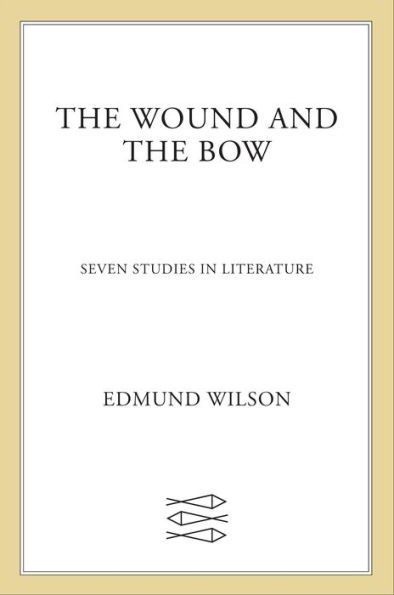In this classic work, "the greatest literary critic of the 20th century" probes the lives and works of seven great writers (New York Magazine).
Combining biographical and critical sketches, Edmund Wilson searches for the wellspring of artistic genius in this series of seven essays. His wide-ranging subjects include Charles Dickens, Rudyard Kipling, Edith Wharton, Ernest Hemingway, James Joyce, Jacques Casanova, and Sophocles.
The first two studies, of Charles Dickens and Rudyard Kipling, reveal how in each case an unhappy childhood later resulted in mature artistic works. Expanding on this theme in succeeding chapters, Wilson captures the essence of his thesis in the mythical story of Philoctetes, as recounted in the final essay.
The legendary Greek archer was bitten by snake and then afflicted with an incurable, malodorous wound that would not heal. After first being banished, the injured hero was later sought out by his fellow warriors for his prowess with a magic bow, and his skill was ultimately key to the Greek victory at Troy.
"In the best tradition of literary criticism . . . combines exact information with shrewd and searching penetration into the personal life of the artist." —The New York Times
1114857897
Combining biographical and critical sketches, Edmund Wilson searches for the wellspring of artistic genius in this series of seven essays. His wide-ranging subjects include Charles Dickens, Rudyard Kipling, Edith Wharton, Ernest Hemingway, James Joyce, Jacques Casanova, and Sophocles.
The first two studies, of Charles Dickens and Rudyard Kipling, reveal how in each case an unhappy childhood later resulted in mature artistic works. Expanding on this theme in succeeding chapters, Wilson captures the essence of his thesis in the mythical story of Philoctetes, as recounted in the final essay.
The legendary Greek archer was bitten by snake and then afflicted with an incurable, malodorous wound that would not heal. After first being banished, the injured hero was later sought out by his fellow warriors for his prowess with a magic bow, and his skill was ultimately key to the Greek victory at Troy.
"In the best tradition of literary criticism . . . combines exact information with shrewd and searching penetration into the personal life of the artist." —The New York Times
The Wound and the Bow: Seven Studies in Literature
In this classic work, "the greatest literary critic of the 20th century" probes the lives and works of seven great writers (New York Magazine).
Combining biographical and critical sketches, Edmund Wilson searches for the wellspring of artistic genius in this series of seven essays. His wide-ranging subjects include Charles Dickens, Rudyard Kipling, Edith Wharton, Ernest Hemingway, James Joyce, Jacques Casanova, and Sophocles.
The first two studies, of Charles Dickens and Rudyard Kipling, reveal how in each case an unhappy childhood later resulted in mature artistic works. Expanding on this theme in succeeding chapters, Wilson captures the essence of his thesis in the mythical story of Philoctetes, as recounted in the final essay.
The legendary Greek archer was bitten by snake and then afflicted with an incurable, malodorous wound that would not heal. After first being banished, the injured hero was later sought out by his fellow warriors for his prowess with a magic bow, and his skill was ultimately key to the Greek victory at Troy.
"In the best tradition of literary criticism . . . combines exact information with shrewd and searching penetration into the personal life of the artist." —The New York Times
Combining biographical and critical sketches, Edmund Wilson searches for the wellspring of artistic genius in this series of seven essays. His wide-ranging subjects include Charles Dickens, Rudyard Kipling, Edith Wharton, Ernest Hemingway, James Joyce, Jacques Casanova, and Sophocles.
The first two studies, of Charles Dickens and Rudyard Kipling, reveal how in each case an unhappy childhood later resulted in mature artistic works. Expanding on this theme in succeeding chapters, Wilson captures the essence of his thesis in the mythical story of Philoctetes, as recounted in the final essay.
The legendary Greek archer was bitten by snake and then afflicted with an incurable, malodorous wound that would not heal. After first being banished, the injured hero was later sought out by his fellow warriors for his prowess with a magic bow, and his skill was ultimately key to the Greek victory at Troy.
"In the best tradition of literary criticism . . . combines exact information with shrewd and searching penetration into the personal life of the artist." —The New York Times
17.99
In Stock
5
1

The Wound and the Bow: Seven Studies in Literature
266
The Wound and the Bow: Seven Studies in Literature
266eBook (Digital Original)
$17.99
Related collections and offers
17.99
In Stock

Product Details
| ISBN-13: | 9781466899612 |
|---|---|
| Publisher: | Farrar, Straus and Giroux |
| Publication date: | 05/01/2024 |
| Sold by: | Barnes & Noble |
| Format: | eBook |
| Pages: | 266 |
| File size: | 1 MB |
About the Author
What People are Saying About This
From the B&N Reads Blog
